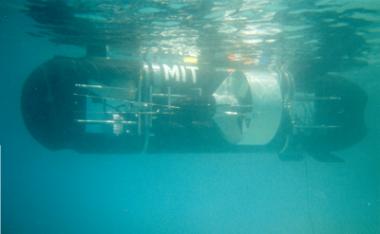The ORCA IV Vehicle
Overview
 This years sub follows a design philosophy of incremental improvement of
previous year's designs. The vehicle has kept the same physical design as
the previous two years, as well as the sonar altimeter and pressure
sensor. The magnetic compass and doppler velocity log have been upgraded
in performance capabilities, and an entirely new digital light sensor has
been added.
This years sub follows a design philosophy of incremental improvement of
previous year's designs. The vehicle has kept the same physical design as
the previous two years, as well as the sonar altimeter and pressure
sensor. The magnetic compass and doppler velocity log have been upgraded
in performance capabilities, and an entirely new digital light sensor has
been added.
Hull Design
The ORCA IV hull is nearly identical to its predecessors in that it's
designed for maximum stability and ease of upgradability. The ORCA IV is
split into three main modules fore-and-aft. The central portion contains
two water tight tubes which house the main electronics and power
assemblies. The horizontal thrusters are also attached to the side of the
center module. The bow and stern compartments are flooded and contain
vertical thrusters, the environmental sensor package and and
mission-specific equipment.
 The vehicle has been very carefully designed to have a great upright
stability. The batteries, since they are extremely heavy, are placed as
low as possible in the hull, giving the sub very good static stability.
The bow and stern sections swing outward away from the center module,
allowing for easy access to the electronics assemblage.
The vehicle has been very carefully designed to have a great upright
stability. The batteries, since they are extremely heavy, are placed as
low as possible in the hull, giving the sub very good static stability.
The bow and stern sections swing outward away from the center module,
allowing for easy access to the electronics assemblage.
Sensors and Electronics
The ORCA IV contains some new sensors this year to facilitate an overall
increase in sub performance. New sensors include a Sontech Argonaut
doppler velocity log, a Honeywell HMR3000 magnetic compass and custom built
digital light sensor. The submarine uses a combination of the doppler
velocity log, compass, pressure sensor and a homemade inertial measurement
unit to build a picture of itself in relation to the world.
The vehicle is controlled by a software suite running on a pentium-class
processor, built into a PC-104 hardware stack, running the Linux operating
system. The control system for the submarine can be remotely accessed by a
900 MHz radio modem at short underwater distances, or by an ethernet cable
fashioned into a tether.
Additional Information
Additional and more detailed information about ORCA IV can be found in the
Articles and Press section
of this site.
|


 Copyright 1998-2009 MIT.
Copyright 1998-2009 MIT.
 This years sub follows a design philosophy of incremental improvement of
previous year's designs. The vehicle has kept the same physical design as
the previous two years, as well as the sonar altimeter and pressure
sensor. The magnetic compass and doppler velocity log have been upgraded
in performance capabilities, and an entirely new digital light sensor has
been added.
This years sub follows a design philosophy of incremental improvement of
previous year's designs. The vehicle has kept the same physical design as
the previous two years, as well as the sonar altimeter and pressure
sensor. The magnetic compass and doppler velocity log have been upgraded
in performance capabilities, and an entirely new digital light sensor has
been added.
 The vehicle has been very carefully designed to have a great upright
stability. The batteries, since they are extremely heavy, are placed as
low as possible in the hull, giving the sub very good static stability.
The bow and stern sections swing outward away from the center module,
allowing for easy access to the electronics assemblage.
The vehicle has been very carefully designed to have a great upright
stability. The batteries, since they are extremely heavy, are placed as
low as possible in the hull, giving the sub very good static stability.
The bow and stern sections swing outward away from the center module,
allowing for easy access to the electronics assemblage.